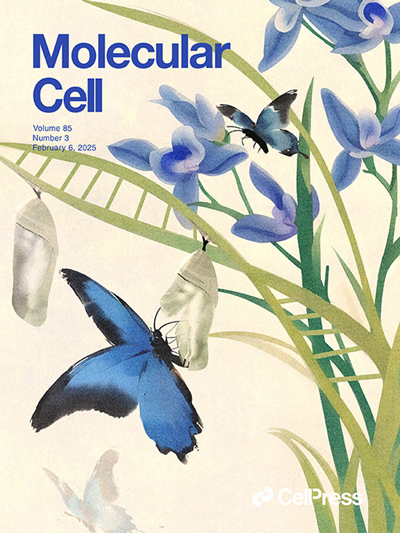Volumen 85, Número 3
Zhanzhan Xu1,4 ∙ Chen Nie1,4 ∙ Junwei Liao1 ∙ Yujie Ma1 ∙ Xiao Albert Zhou1 ∙ Xiaoman Li1 ∙ Shiwei Li1 ∙ Haodong Lin1 ∙ Yefei Luo1 ∙ Kaiqi Cheng1 ∙ Zuchao Mao1 ∙ Lei Zhang1 ∙ Yichen Pan1 ∙ Yuke Chen2 ∙ Weibin Wang1 weibinwang@bjmu.edu.cn ∙ Jiadong Wang1,3,5

La portada de este número de Célula molecular es "DDX39A resuelve los híbridos de ARN-ADN asociados a la horquilla de replicación para equilibrar la protección y la escisión de la horquilla para el mantenimiento de la estabilidad genómica." publicado por Profesor Wang Jiadong y Investigador asociado Wang Weibin de la Universidad de Pekín.

Antecedentes de investigación
Durante la replicación del ADN, garantizar la estabilidad de las horquillas de replicación en regiones transcripcionalmente activas es esencial para una replicación precisa y la prevención de mutaciones. Las horquillas de replicación son dos estructuras en forma de Y que desenrollan la doble hélice y avanzan en ambas direcciones durante la replicación del ADN. En las regiones transcripcionalmente activas, se puede generar un entorno molecular complejo debido a la actividad simultánea de la ARN polimerasa y la ADN polimerasa, lo que supone un reto para la estabilidad de las horquillas de replicación. El fundamento de este estudio se basa en la pregunta científica de cómo mantener la estabilidad de las horquillas de replicación en regiones transcripcionalmente activas para prevenir el daño y las mutaciones del ADN.
Importancia de la investigación
Este estudio descubrió por primera vez híbridos ARN-ADN asociados a horquillas de replicación (RF-RD) ubicuos en regiones transcripcionalmente activas de células humanas. Estos híbridos actúan como una barrera protectora que previene la degradación del ADN naciente mediada por DNA2 y el colapso de la horquilla de replicación bajo estrés replicativo. Este descubrimiento revela una nueva función de las interacciones ARN-ADN en el mantenimiento de la estabilidad de la horquilla de replicación. El estudio también identificó a DDX39A como una proteína asociada a RAD51 que se une a las horquillas de replicación bloqueadas y resuelve los RF-RD, promoviendo así la resección del ADN mediada por DNA2 y el reinicio de la horquilla de replicación. Este descubrimiento proporciona una nueva perspectiva para comprender el reinicio de la horquilla de replicación y la reparación del daño al ADN.
El estudio también demostró que la disolución excesiva de RF-RD puede provocar el colapso de la horquilla de replicación y la inestabilidad genómica, mientras que la disolución insuficiente de RF-RD bajo estrés replicativo aumenta la estabilidad de la horquilla de replicación y genera resistencia a la quimioterapia. Este hallazgo destaca el papel equilibrador de los RF-RD en el mantenimiento de la estabilidad de la horquilla de replicación y la sensibilidad a la quimioterapia.
Perspectivas de investigación
Basándose en el papel clave de los RF-RD en el mantenimiento de la estabilidad de las horquillas de replicación y la sensibilidad a la quimioterapia, estudios futuros pueden explorar la focalización de los RF-RD como una nueva estrategia para mejorar la eficacia de la quimioterapia. Al regular la formación y disolución de los RF-RD, podría ser posible mejorar la respuesta de algunos pacientes con cáncer a los fármacos quimioterapéuticos. Si bien este estudio reveló el papel de los RF-RD y DDX39A en la estabilidad de las horquillas de replicación, aún existen muchos misterios sin resolver. Por ejemplo, el mecanismo específico de formación de los RF-RD, cómo DDX39A reconoce y se une a las horquillas de replicación bloqueadas, y la interacción entre los RF-RD y otras vías de reparación del ADN son áreas importantes para futuras investigaciones.
Para profundizar en el estudio de los RF-RD y la estabilidad de las horquillas de replicación, es necesario desarrollar nuevas herramientas y tecnologías para monitorizar la formación, los cambios dinámicos y la interacción de los RF-RD con las horquillas de replicación en tiempo real. Estas herramientas y técnicas ayudarán a revelar más detalles sobre los mecanismos de replicación y reparación del ADN.
Proceso de diseño de portada
Nuestro horario
Lun 21/11 - Miércoles 23/11: 9 a.m. - 8 p.m.
Jueves 24/11: cerrado - ¡Feliz Día de Acción de Gracias!
Viernes 25/11: 8 a.m. - 10 p.m.
Sábado 26/11 - Dom 27/11: 10 a.m. - 9 p.m.
(todas las horas son hora del este)